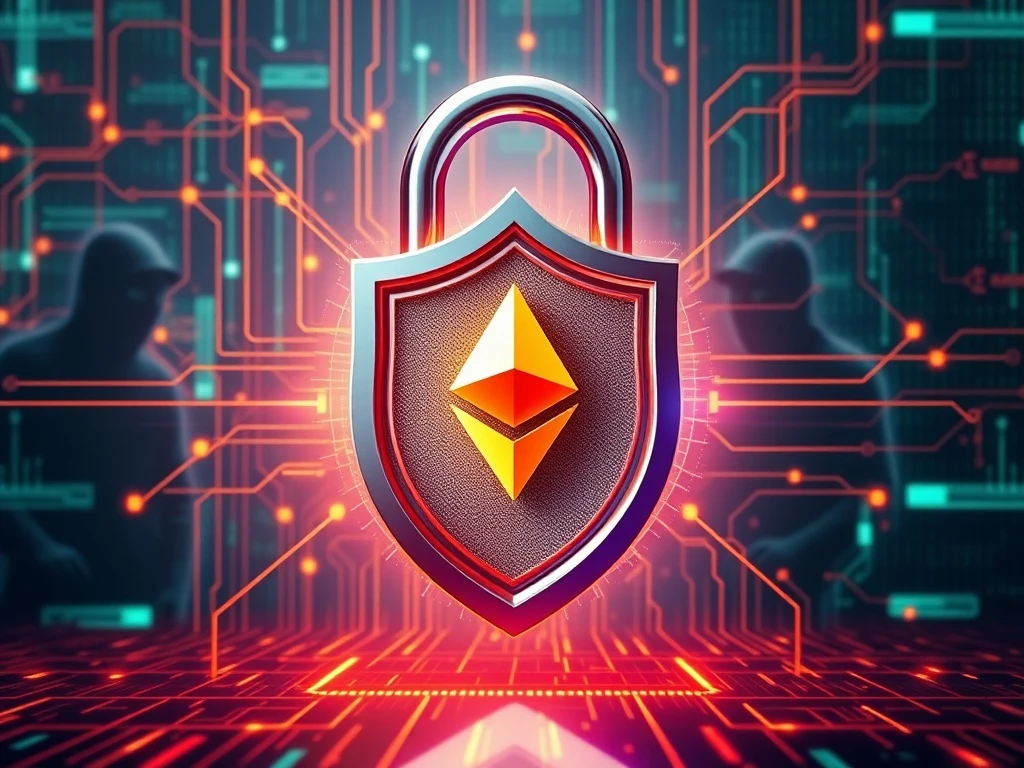Cryptocurrency Security: Unlocking Vital Defenses Against Cyber Threats

In the exhilarating world of cryptocurrencies, the promise of wealth creation often walks hand-in-hand with significant risks. While the decentralized nature of digital assets offers unparalleled freedom, it also presents unique vulnerabilities that traditional finance rarely encounters. Every year, billions are lost to breaches and scams, leaving investors with little to no recourse. This reality underscores a critical truth: robust cryptocurrency security isn’t just an option; it’s an absolute necessity. Protecting your digital fortune requires a proactive, multi-layered approach, blending technological safeguards with informed behavioral practices. Let’s dive deep into the landscape of threats and discover how you can fortify your defenses.
Understanding the Landscape of Cryptocurrency Security Threats
The allure of digital assets is undeniable, but so are the shadows lurking within the ecosystem. The decentralized nature of blockchain technology, while a core strength, means there’s no central authority to bail you out if something goes wrong. This places the onus squarely on individual investors to be their own bank and their own security guard. So, what are the primary dangers that threaten your holdings?
- Exchange Hacks: Centralized cryptocurrency exchanges, despite their security efforts, remain prime targets for sophisticated cybercriminals. Billions have been siphoned off from these platforms over the years, impacting countless users.
- Phishing Attacks: These are insidious attempts to trick you into revealing sensitive information, like your private keys or login credentials. Phishing often involves fake websites or emails that perfectly mimic legitimate platforms, creating a deceptive trap.
- Malware: Malicious software can infect your device, silently monitoring your activities, stealing wallet files, or even altering transaction details as you send them.
- Rug Pulls: A type of scam where developers of a new cryptocurrency project suddenly abandon it, selling off all their pre-mined coins and leaving investors with worthless tokens. These exploit the excitement around new projects and the fear of missing out (FOMO).
- Human Error: Sometimes, the biggest threat is ourselves. Misplacing a seed phrase, sending funds to the wrong address, or falling for social engineering tactics can lead to irreversible losses.
Each of these threats exploits different facets of the crypto environment, from technological vulnerabilities to human psychology. Understanding them is the first step towards building impenetrable cryptocurrency security.
Implementing Multi-Layered Digital Asset Protection
Given the array of threats, a single security measure simply won’t cut it. Experts universally advocate for a multi-layered defense strategy, akin to fortifying a castle with multiple walls. This comprehensive approach significantly enhances your digital asset protection, making it exponentially harder for malicious actors to succeed.
The Cornerstone: Hardware Wallets
For long-term holdings and significant amounts of crypto, hardware wallets are indispensable. These physical devices store your private keys offline, completely isolated from internet-connected computers. This ‘cold storage’ method makes them virtually immune to online hacks and malware. Think of it as keeping your most valuable jewels in a bank vault, not under your mattress.
Software Wallets: Convenience with Caution
While hardware wallets are ideal for cold storage, software wallets (or ‘hot wallets’) are convenient for active trading and smaller amounts. They reside on your computer or smartphone and are always connected to the internet. While less secure than hardware wallets, they can be used safely with enhanced safeguards.
Here’s a quick comparison:
| Feature | Hardware Wallet | Software Wallet (Hot Wallet) |
|---|---|---|
| Security | Excellent (offline private keys, cold storage) | Good (online, susceptible to malware/hacks if device compromised) |
| Accessibility | Requires physical device, less convenient for frequent trades | Highly convenient, accessible from multiple devices |
| Cost | Initial purchase cost (one-time) | Free (typically) |
| Use Case | Long-term storage, large holdings (cold storage) | Active trading, smaller amounts (hot storage) |
| Vulnerabilities | Physical damage, loss, supply chain attacks (rare) | Malware, phishing, exchange hacks, device compromise |
Crucial Safeguards for All Wallet Types:
- Two-Factor Authentication (2FA): Always enable 2FA on exchanges and wallets. However, be wary of SMS-based 2FA, which is vulnerable to SIM-swap attacks. Authenticator apps (like Google Authenticator or Authy) are a much more secure alternative.
- Seed Phrase Management: Your seed phrase (or recovery phrase) is the master key to your crypto assets. It should be stored offline, away from any digital format like cloud backups or screenshots. Consider splitting it into multiple parts and storing them in different secure locations for added redundancy and security.
- Diversify Storage: Don’t put all your eggs in one basket. Distribute your holdings across multiple wallet types and platforms. This reduces your exposure to single-point failures, whether it’s an exchange hack or a lost hardware wallet.
- Regular Software Updates: Keep your wallet software, operating system, and antivirus programs updated. Developers frequently release patches for newly discovered vulnerabilities.
Navigating Crypto Scams and Phishing Attacks with Diligence
Beyond technical safeguards, human vigilance is your most potent weapon against deception. Crypto scams and phishing attacks prey on urgency, greed, and a lack of information. Here’s how to cultivate the due diligence necessary to protect yourself:
- Verify Everything: Phishing attempts are incredibly sophisticated. Always double-check URLs before entering any credentials. Look for subtle misspellings or unusual domains. Bookmark legitimate exchange and wallet sites and use those bookmarks instead of clicking links from emails or social media.
- Be Skeptical of Unsolicited Offers: If it sounds too good to be true, it almost certainly is. Beware of messages promising guaranteed high returns, free crypto giveaways, or urgent calls to action. Legitimate projects rarely operate this way.
- Research Before Investing: Before putting your hard-earned money into any new project, conduct thorough research. Fraudulent schemes like rug pulls thrive on uninformed investors chasing quick profits. Look for whitepapers, team transparency, community engagement, and genuine utility.
- Understand the Project: Can you articulate what the project does and why it has value? If not, you might be investing in hype rather than substance. Scammers often use complex jargon to obscure their true intentions.
- Use Reputable Sources: Rely on established news outlets, reputable analysts, and official project channels for information. Be wary of information solely shared on anonymous forums or unverified social media accounts.
The Role of AI in Enhancing Cryptocurrency Security
While individual responsibility is paramount, technology is also evolving to offer new layers of defense. AI-driven platforms are emerging as powerful allies in the fight against fraud and volatility, providing sophisticated tools to augment your personal due diligence.
Platforms like Token Metrics leverage artificial intelligence to assess project viability, flagging high-risk tokens and identifying legitimate early-stage opportunities. How do they do this?
- Algorithmic Risk Analysis: AI algorithms can process vast amounts of data – including whitepapers, team backgrounds, social media sentiment, and blockchain transaction patterns – to identify anomalies and red flags that human analysts might miss. This helps in pinpointing potential rug pulls or unsustainable projects.
- Real-Time Market Tracking: AI can monitor market movements and trading volumes in real-time, detecting unusual activity that might indicate manipulation or a sudden exit scam.
- Narrative Analysis: Beyond raw data, AI can analyze the prevailing narratives around cryptocurrencies. This helps users sidestep trending but risky market trends driven by hype rather than fundamentals, providing a more objective view of the market sentiment and potential for pump-and-dump schemes.
By leveraging AI-powered risk assessment, investors gain an analytical edge, helping them avoid volatile or fraudulent assets and make more informed decisions. These tools don’t replace personal vigilance but amplify it, adding a powerful layer of analytical support to your cryptocurrency security strategy.
Staying Ahead: Continuous Education and Vigilance
The cryptocurrency landscape is dynamic, constantly evolving with new technologies, regulations, and, unfortunately, new threats. Staying informed is not a one-time task but a continuous commitment. Credible news sources, security alerts, and community forums are invaluable resources for keeping abreast of emerging dangers and best practices.
The analysis underscores that crypto security hinges on proactive measures and informed decision-making. While hardware wallets and robust 2FA form the technical backbone of protection, behavioral practices—such as skepticism toward unsolicited links, rigorous project vetting, and understanding the nuances of phishing attacks—are equally essential. Technological solutions, including AI-powered risk assessment, amplify these efforts by offering layers of analytical support. However, the onus remains on individuals to implement these strategies, as the irreversible nature of crypto transactions leaves no recourse for stolen funds. Your commitment to learning and adapting is your ultimate shield in this digital frontier.
Frequently Asked Questions (FAQs)
1. What are the biggest cryptocurrency security threats?
The biggest threats include exchange hacks, where centralized platforms are breached; phishing attacks, which trick users into revealing sensitive information; malware designed to steal crypto; rug pulls, where project developers abandon their token; and human error, such as misplacing private keys or falling for social engineering.
2. How do hardware wallets enhance digital asset protection?
Hardware wallets significantly enhance digital asset protection by storing your private keys offline (cold storage), making them immune to online hacks, malware, and other software-based attacks. They require physical confirmation for transactions, adding an extra layer of security.
3. What are common crypto scams and how can I avoid them?
Common crypto scams include phishing (fake websites/emails), rug pulls (developers abandoning projects), fake giveaways, and imposter scams. To avoid them, always verify URLs, be skeptical of unsolicited offers, research projects thoroughly before investing, and never share your private keys or seed phrases.
4. How can AI tools help improve crypto security?
AI tools, like those offered by platforms such as Token Metrics, can improve crypto security by performing algorithmic risk analysis, identifying high-risk tokens, and detecting fraudulent projects (like rug pulls) through real-time market tracking and narrative analysis. They provide data-driven insights to help investors make safer decisions.
5. Why is continuous education vital for crypto security?
The cryptocurrency landscape is rapidly evolving, with new technologies, regulations, and attack vectors emerging constantly. Continuous education ensures you stay informed about the latest threats and security best practices, enabling you to adapt your defense strategies and protect your assets effectively.
6. Can stolen cryptocurrency funds be recovered?
Generally, no. Due to the decentralized and irreversible nature of blockchain transactions, once cryptocurrency funds are stolen and moved to another address, they are extremely difficult, if not impossible, to recover. This is why proactive security measures are absolutely critical.









